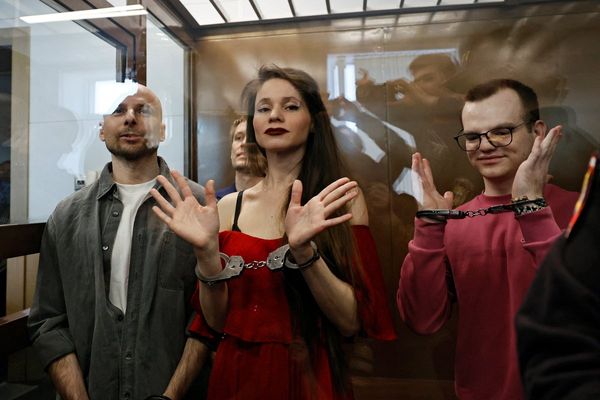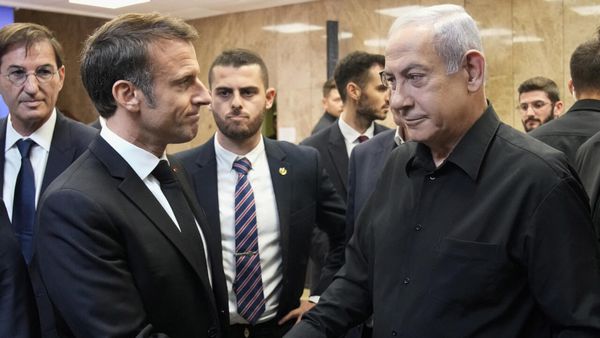
Myth isn’t just storytelling; it wells out of the collective unconscious, a primal response to the complexity of being human. We return to myths again and again, like helpless children, to better understand our fundamental natures and primordial urges.
If there is a strange familiarity in Anaïs Mitchell’s musical Hadestown – a Tony award-winning reworking of the myth of Orpheus and Eurydice – it’s because we know this story and, poignantly, how it ends. Perhaps telling it again might bring about a different outcome?
There are actually two myths here, entwining and looping back on each other: Orpheus (Noah Mullins) and his attempt to rescue Eurydice (Abigail Adriano) from the underworld is the central plot, but we also have their tormentor Hades (Adrian Tamburini) and his tempestuous love for wife, Persephone (Elenoa Rokobaro). It’s a neat combination, allowing for similarities to emerge, ideas around companionship and control, desire and doubt. It has to sidestep some troublesome associations – Hades doesn’t abduct or rape Persephone here, and Eurydice chooses her own descent into the underworld – but it also draws chilling contemporary parallels.
Hadestown is set in a kind of Depression-era Louisiana piano bar, with the cast and musicians seemingly ad-libbing the composition on the spot. It’s an ingenious way to strip the story of superfluous detail, and dovetails brilliantly with the musical influences underpinning the score – surely one of the richest in recent musical theatre history. There’s plenty of jazz and blues, of course, but also call and response, ragtime and even some honky-tonk. It’s a particularly American tradition.
Characterisation in the show (and in myth generally) tends to be static and gestural rather than psychological or fully explored. Orpheus is “a lover/poet” and Eurydice “hungry and poor”. Hadestown is less interested in narrative turning points or plot development, content to luxuriate in its own atmosphere, which is thankfully heady and lush. There’s a keen awareness of the power of resonance and – with themes of despotism, worker exploitation and climate catastrophe woven through – it’s also deeply political.
This Australian premiere follows several successful productions overseas, so it’s something of a shock when the show has to be stopped 10 minutes in, due to technical problems. The sung-through score is so finely calibrated, its tonal shifts so minutely judged, that this interruption threatens to kill the mood entirely.
The cast (and to a lesser extent the musicians) seem spooked, and while they do manage to shake it off, it does major damage to the production’s confidence. On opening night? Well, it’s a disaster.
But Hadestown is a show with a fire in its belly, determined and articulate, and soon the production picks up speed and vibrancy. The arrival of Persephone – who gets six months’ reprieve from the underworld each year and celebrates with a rousing drinking song – Livin’ it Up on Top – raises the temperature. Rokobaro effortlessly dominates, her powerful vocals shaded by a dusky lower register. When Hades himself arrives soon after, things get decidedly steamy.
The conceptualisation of Hades, “the king of the mine”, is pure genius. Decked in a full-length black leather coat over a stunning black pinstripe suit, he looks like a cross between The Matrix’s Agent Smith and a particularly dodgy magician. Tamburini’s silken bass-baritone perfectly captures the character’s menace and suavity, and the production soars whenever he’s on stage.
Christine Anu is less convincing as the show’s narrator, Hermes. She has a powerful voice, but seems unmoored much of the time, even superfluous.
As the young lovers, Adriano and Mullins start tremulously but build to great heights. Adriano has some serious vocal chops and manages to find depth and pathos in the underwritten part of the lover who must be rescued. Mullins, stretched to high falsetto for much of the time, carves out a portrait of ardent commitment and self-sacrifice; that soaring tenor perfectly articulates the idea of the poet who can sing change into the world.
The production, apart from the opening stumble, is slick and muscular.
Rachel Chavkin directs with a consummate sense of the show’s pacing and micro-climates, the way it slides in and out of modes and moods. Rachel Hauk’s speakeasy set is simple but effective, while Bradley King’s maximalist lighting works hard to conjure party atmospheres that turn to subterranean hellscapes. Michael Krass’s costumes are gorgeous and thoughtfully detailed, and David Neumann’s choreography is sassy and sharp.
It’s the kind of polish we see in many imported big-ticket musicals, but it also undermines Hadestown’s natural groove somewhat, its intrinsic spirit of improvisation. Perhaps it will loosen up over the coming weeks, and find a greater sense of abandon.
Hadestown won’t be for everyone who loves musical theatre. Its looping narrative structure and insistent musical motifs might lull some people into a sense of deja-vu. But then myth is like that; constantly rewriting itself, it’s the snake that eats its tail. Mitchell’s great achievement lies in her ability to refract contemporary ideas – social, psychological and especially political – through the prism of “an old song, a sad tale, a tragedy”.
No spoilers, but this story has played out before.
Hadestown is running at the Theatre Royal Sydney before it opens at Her Majesty’s theatre in Melbourne in May







